2014 Hyundai Santa Fe warning
[x] Cancel search: warningPage 84 of 711
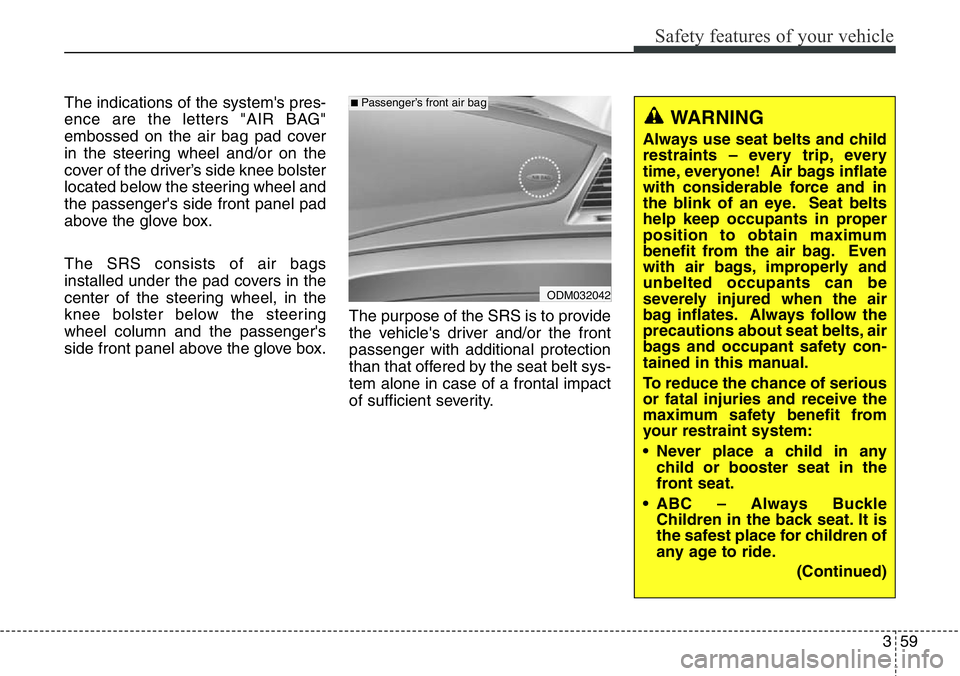
359
Safety features of your vehicle
The indications of the system's pres-
ence are the letters "AIR BAG"
embossed on the air bag pad cover
in the steering wheel and/or on the
cover of the driver’s side knee bolster
located below the steering wheel and
the passenger's side front panel pad
above the glove box.
The SRS consists of air bags
installed under the pad covers in the
center of the steering wheel, in the
knee bolster below the steering
wheel column and the passenger's
side front panel above the glove box.The purpose of the SRS is to provide
the vehicle's driver and/or the front
passenger with additional protection
than that offered by the seat belt sys-
tem alone in case of a frontal impact
of sufficient severity.
ODM032042
■Passenger’s front air bag
WARNING
Always use seat belts and child
restraints – every trip, every
time, everyone! Air bags inflate
with considerable force and in
the blink of an eye. Seat belts
help keep occupants in proper
position to obtain maximum
benefit from the air bag. Even
with air bags, improperly and
unbelted occupants can be
severely injured when the air
bag inflates. Always follow the
precautions about seat belts, air
bags and occupant safety con-
tained in this manual.
To reduce the chance of serious
or fatal injuries and receive the
maximum safety benefit from
your restraint system:
• Never place a child in any
child or booster seat in the
front seat.
• ABC – Always Buckle
Children in the back seat. It is
the safest place for children of
any age to ride.
(Continued)
Page 85 of 711
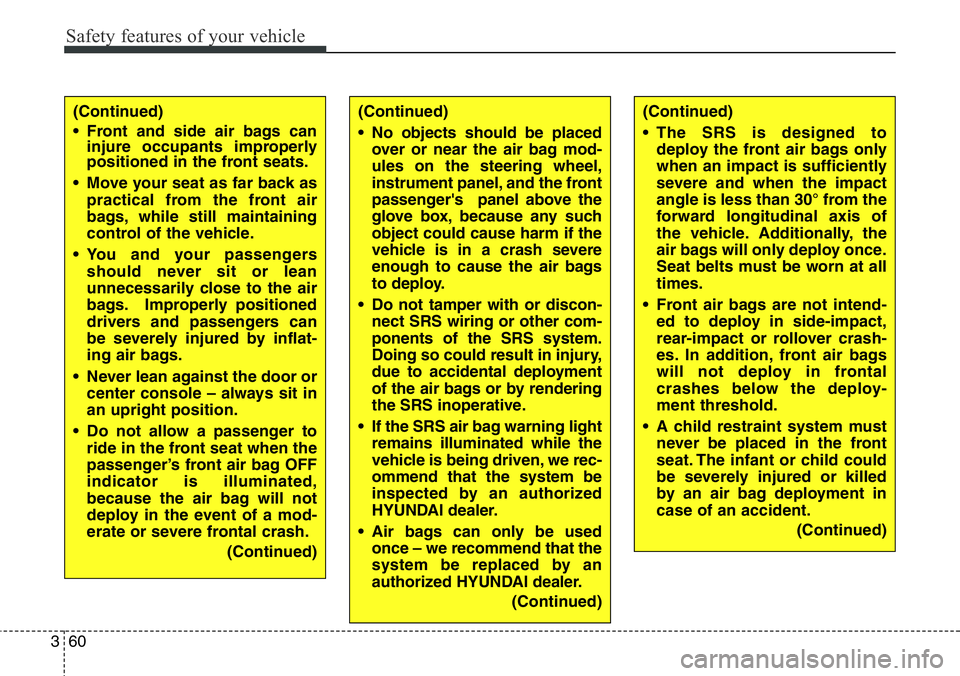
Safety features of your vehicle
60 3
(Continued)
• The SRS is designed to
deploy the front air bags only
when an impact is sufficiently
severe and when the impact
angle is less than 30° from the
forward longitudinal axis of
the vehicle. Additionally, the
air bags will only deploy once.
Seat belts must be worn at all
times.
• Front air bags are not intend-
ed to deploy in side-impact,
rear-impact or rollover crash-
es. In addition, front air bags
will not deploy in frontal
crashes below the deploy-
ment threshold.
• A child restraint system must
never be placed in the front
seat. The infant or child could
be severely injured or killed
by an air bag deployment in
case of an accident.
(Continued)(Continued)
• No objects should be placed
over or near the air bag mod-
ules on the steering wheel,
instrument panel, and the front
passenger's panel above the
glove box, because any such
object could cause harm if the
vehicle is in a crash severe
enough to cause the air bags
to deploy.
• Do not tamper with or discon-
nect SRS wiring or other com-
ponents of the SRS system.
Doing so could result in injury,
due to accidental deployment
of the air bags or by rendering
the SRS inoperative.
• If the SRS air bag warning light
remains illuminated while the
vehicle is being driven, we rec-
ommend that the system be
inspected by an authorized
HYUNDAI dealer.
• Air bags can only be used
once – we recommend that the
system be replaced by an
authorized HYUNDAI dealer.
(Continued)(Continued)
• Front and side air bags can
injure occupants improperly
positioned in the front seats.
• Move your seat as far back as
practical from the front air
bags, while still maintaining
control of the vehicle.
• You and your passengers
should never sit or lean
unnecessarily close to the air
bags. Improperly positioned
drivers and passengers can
be severely injured by inflat-
ing air bags.
• Never lean against the door or
center console – always sit in
an upright position.
• Do not allow a passenger to
ride in the front seat when the
passenger’s front air bag OFF
indicator is illuminated,
because the air bag will not
deploy in the event of a mod-
erate or severe frontal crash.
(Continued)
Page 87 of 711
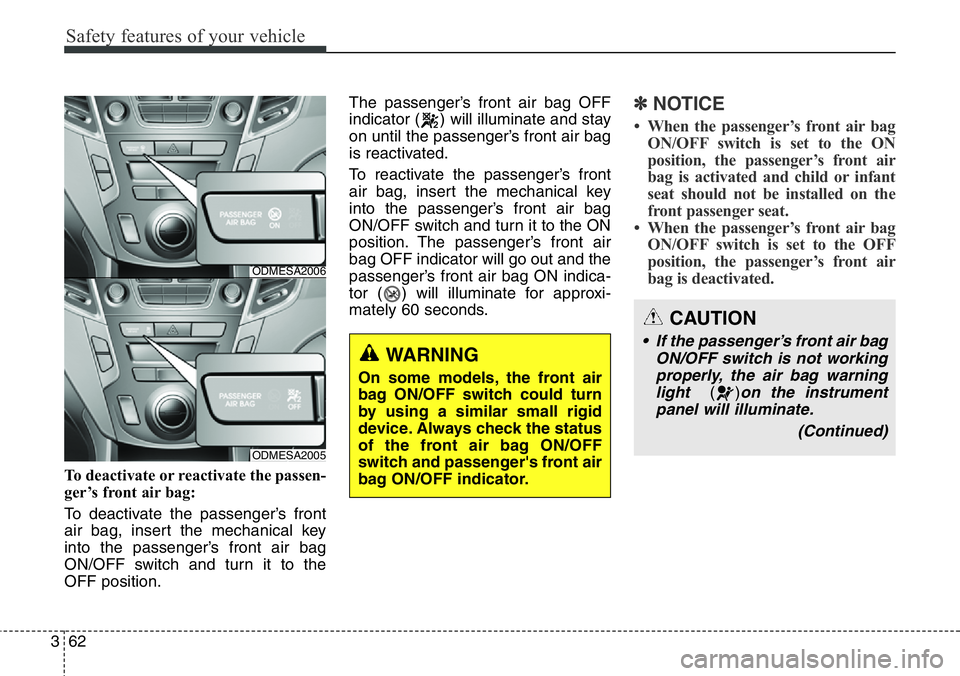
Safety features of your vehicle
62 3
To deactivate or reactivate the passen-
ger’s front air bag:
To deactivate the passenger’s front
air bag, insert the mechanical key
into the passenger’s front air bag
ON/OFF switch and turn it to the
OFF position.The passenger’s front air bag OFF
indicator ( ) will illuminate and stay
on until the passenger’s front air bag
is reactivated.
To reactivate the passenger’s front
air bag, insert the mechanical key
into the passenger’s front air bag
ON/OFF switch and turn it to the ON
position. The passenger’s front air
bag OFF indicator will go out and the
passenger’s front air bag ON indica-
tor ( ) will illuminate for approxi-
mately 60 seconds.
✽NOTICE
• When the passenger’s front air bag
ON/OFF switch is set to the ON
position, the passenger’s front air
bag is activated and child or infant
seat should not be installed on the
front passenger seat.
• When the passenger’s front air bag
ON/OFF switch is set to the OFF
position, the passenger’s front air
bag is deactivated.
WARNING
On some models, the front air
bag ON/OFF switch could turn
by using a similar small rigid
device. Always check the status
of the front air bag ON/OFF
switch and passenger's front air
bag ON/OFF indicator.
CAUTION
• If the passenger’s front air bag
ON/OFF switch is not working
properly, the air bag warning
light
()on the instrument
panel will illuminate.
(Continued)
ODMESA2006
ODMESA2005
Page 88 of 711
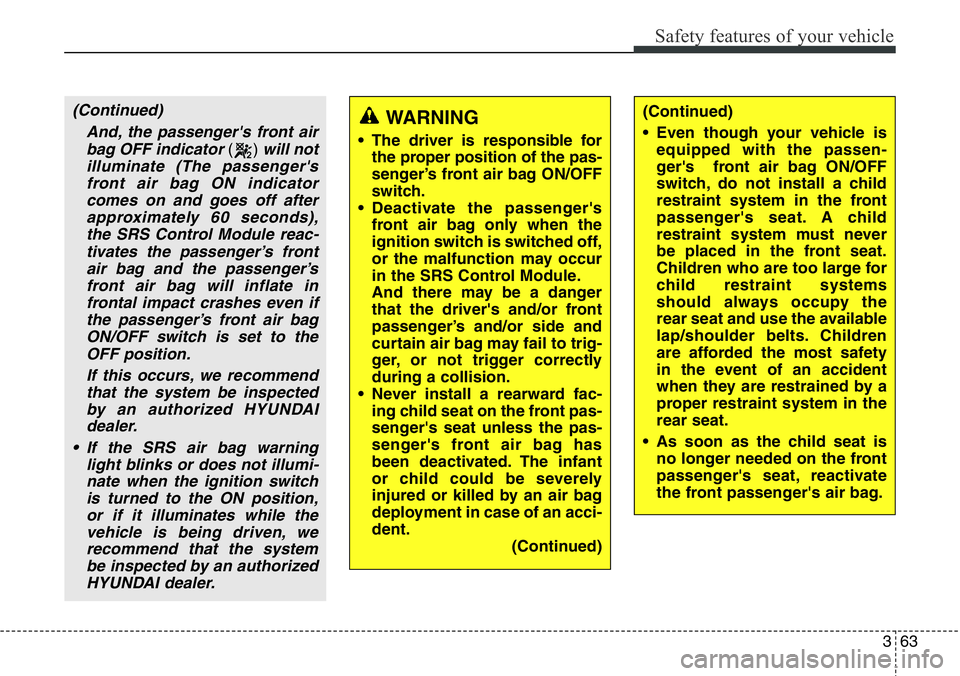
363
Safety features of your vehicle
(Continued)
• Even though your vehicle is
equipped with the passen-
ger's front air bag ON/OFF
switch, do not install a child
restraint system in the front
passenger's seat. A child
restraint system must never
be placed in the front seat.
Children who are too large for
child restraint systems
should always occupy the
rear seat and use the available
lap/shoulder belts. Children
are afforded the most safety
in the event of an accident
when they are restrained by a
proper restraint system in the
rear seat.
• As soon as the child seat is
no longer needed on the front
passenger's seat, reactivate
the front passenger's air bag.WARNING
• The driver is responsible for
the proper position of the pas-
senger’s front air bag ON/OFF
switch.
• Deactivate the passenger's
front air bag only when the
ignition switch is switched off,
or the malfunction may occur
in the SRS Control Module.
And there may be a danger
that the driver's and/or front
passenger’s and/or side and
curtain air bag may fail to trig-
ger, or not trigger correctly
during a collision.
• Never install a rearward fac-
ing child seat on the front pas-
senger's seat unless the pas-
senger's front air bag has
been deactivated. The infant
or child could be severely
injured or killed by an air bag
deployment in case of an acci-
dent.
(Continued)
(Continued)
And, the passenger's front air
bag OFF indicator
() will not
illuminate (The passenger's
front air bag ON indicator
comes on and goes off after
approximately 60 seconds),
the SRS Control Module reac-
tivates the passenger’s front
air bag and the passenger’s
front air bag will inflate in
frontal impact crashes even if
the passenger’s front air bag
ON/OFF switch is set to the
OFF position.
If this occurs, we recommend
that the system be inspected
by an authorized HYUNDAI
dealer.
• If the SRS air bag warning
light blinks or does not illumi-
nate when the ignition switch
is turned to the ON position,
or if it illuminates while the
vehicle is being driven, we
recommend that the system
be inspected by an authorized
HYUNDAI dealer.
Page 89 of 711
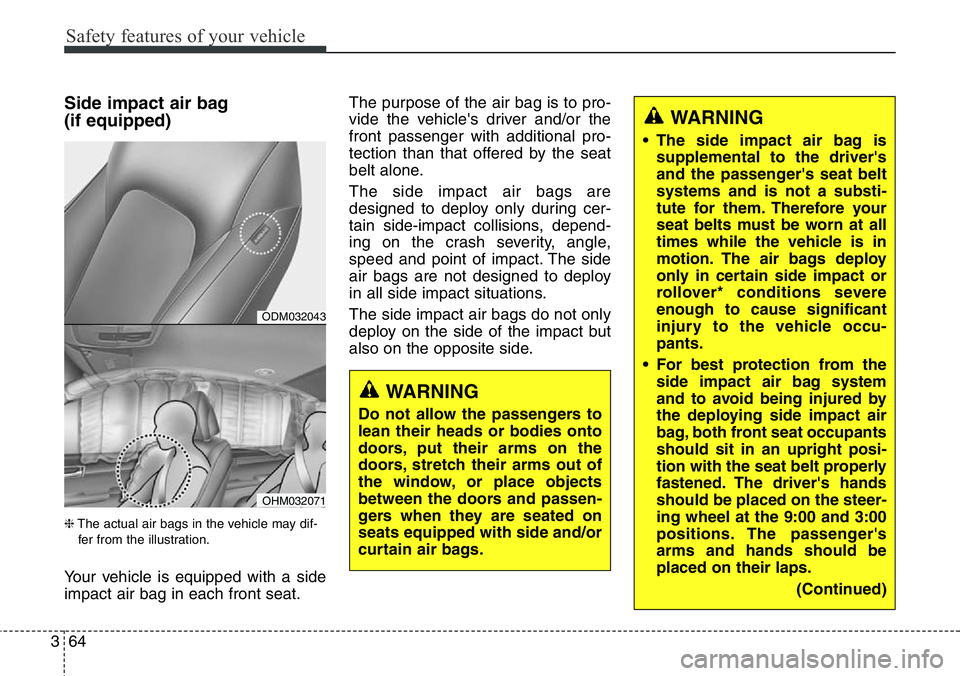
Safety features of your vehicle
64 3
Side impact air bag
(if equipped)
❈The actual air bags in the vehicle may dif-
fer from the illustration.
Your vehicle is equipped with a side
impact air bag in each front seat.The purpose of the air bag is to pro-
vide the vehicle's driver and/or the
front passenger with additional pro-
tection than that offered by the seat
belt alone.
The side impact air bags are
designed to deploy only during cer-
tain side-impact collisions, depend-
ing on the crash severity, angle,
speed and point of impact. The side
air bags are not designed to deploy
in all side impact situations.
The side impact air bags do not only
deploy on the side of the impact but
also on the opposite side.
WARNING
• The side impact air bag is
supplemental to the driver's
and the passenger's seat belt
systems and is not a substi-
tute for them. Therefore your
seat belts must be worn at all
times while the vehicle is in
motion. The air bags deploy
only in certain side impact or
rollover* conditions severe
enough to cause significant
injury to the vehicle occu-
pants.
• For best protection from the
side impact air bag system
and to avoid being injured by
the deploying side impact air
bag, both front seat occupants
should sit in an upright posi-
tion with the seat belt properly
fastened. The driver's hands
should be placed on the steer-
ing wheel at the 9:00 and 3:00
positions. The passenger's
arms and hands should be
placed on their laps.
(Continued)
WARNING
Do not allow the passengers to
lean their heads or bodies onto
doors, put their arms on the
doors, stretch their arms out of
the window, or place objects
between the doors and passen-
gers when they are seated on
seats equipped with side and/or
curtain air bags.
ODM032043
OHM032071
Page 91 of 711
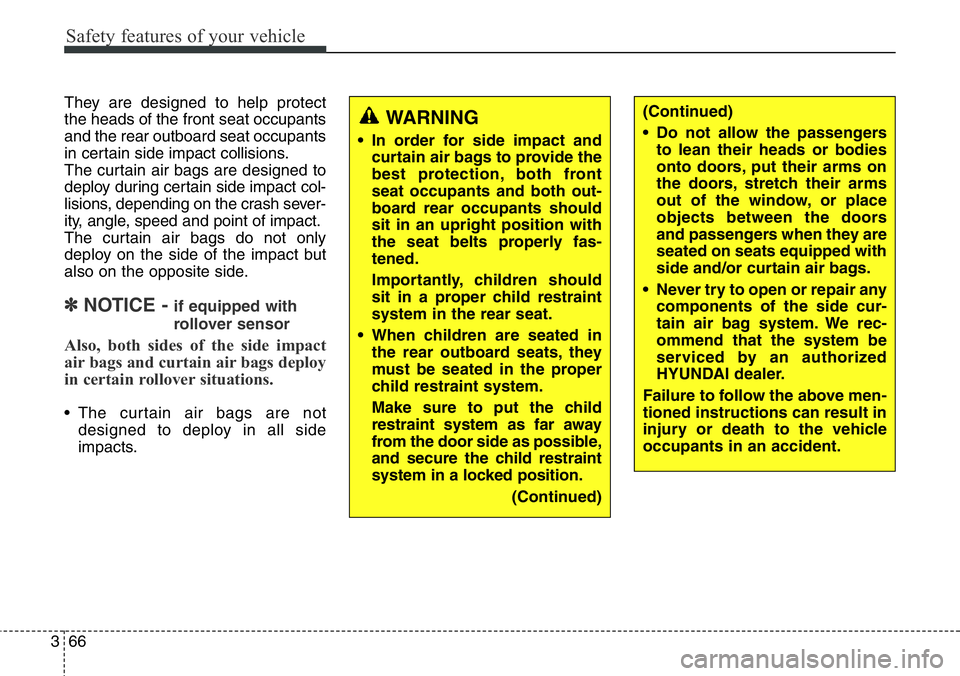
Safety features of your vehicle
66 3
They are designed to help protect
the heads of the front seat occupants
and the rear outboard seat occupants
in certain side impact collisions.
The curtain air bags are designed to
deploy during certain side impact col-
lisions, depending on the crash sever-
ity, angle, speed and point of impact.
The curtain air bags do not only
deploy on the side of the impact but
also on the opposite side.
✽NOTICE - if equipped with
rollover sensor
Also, both sides of the side impact
air bags and curtain air bags deploy
in certain rollover situations.
• The curtain air bags are not
designed to deploy in all side
impacts.
(Continued)
• Do not allow the passengers
to lean their heads or bodies
onto doors, put their arms on
the doors, stretch their arms
out of the window, or place
objects between the doors
and passengers when they are
seated on seats equipped with
side and/or curtain air bags.
• Never try to open or repair any
components of the side cur-
tain air bag system. We rec-
ommend that the system be
serviced by an authorized
HYUNDAI dealer.
Failure to follow the above men-
tioned instructions can result in
injury or death to the vehicle
occupants in an accident.WARNING
• In order for side impact and
curtain air bags to provide the
best protection, both front
seat occupants and both out-
board rear occupants should
sit in an upright position with
the seat belts properly fas-
tened.
Importantly, children should
sit in a proper child restraint
system in the rear seat.
• When children are seated in
the rear outboard seats, they
must be seated in the proper
child restraint system.
Make sure to put the child
restraint system as far away
from the door side as possible,
and secure the child restraint
system in a locked position.
(Continued)
Page 93 of 711
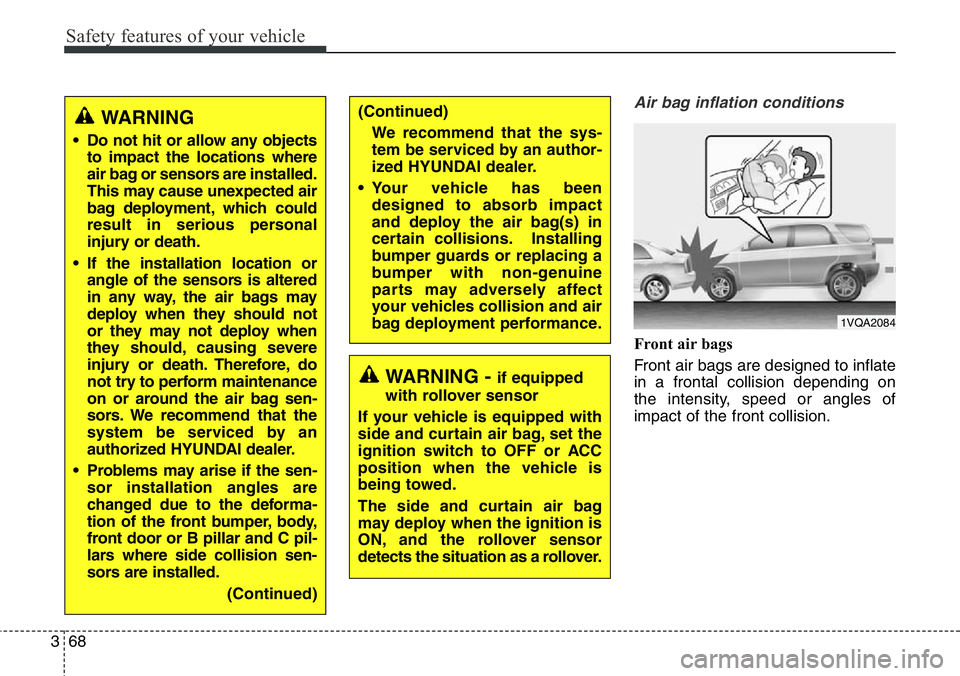
Safety features of your vehicle
68 3
Air bag inflation conditions
Front air bags
Front air bags are designed to inflate
in a frontal collision depending on
the intensity, speed or angles of
impact of the front collision.
WARNING - if equipped
with rollover sensor
If your vehicle is equipped with
side and curtain air bag, set the
ignition switch to OFF or ACC
position when the vehicle is
being towed.
The side and curtain air bag
may deploy when the ignition is
ON, and the rollover sensor
detects the situation as a rollover.
WARNING
• Do not hit or allow any objects
to impact the locations where
air bag or sensors are installed.
This may cause unexpected air
bag deployment, which could
result in serious personal
injury or death.
• If the installation location or
angle of the sensors is altered
in any way, the air bags may
deploy when they should not
or they may not deploy when
they should, causing severe
injury or death. Therefore, do
not try to perform maintenance
on or around the air bag sen-
sors. We recommend that the
system be serviced by an
authorized HYUNDAI dealer.
• Problems may arise if the sen-
sor installation angles are
changed due to the deforma-
tion of the front bumper, body,
front door or B pillar and C pil-
lars where side collision sen-
sors are installed.
(Continued)
(Continued)
We recommend that the sys-
tem be serviced by an author-
ized HYUNDAI dealer.
• Your vehicle has been
designed to absorb impact
and deploy the air bag(s) in
certain collisions. Installing
bumper guards or replacing a
bumper with non-genuine
parts may adversely affect
your vehicles collision and air
bag deployment performance.
1VQA2084
Page 97 of 711
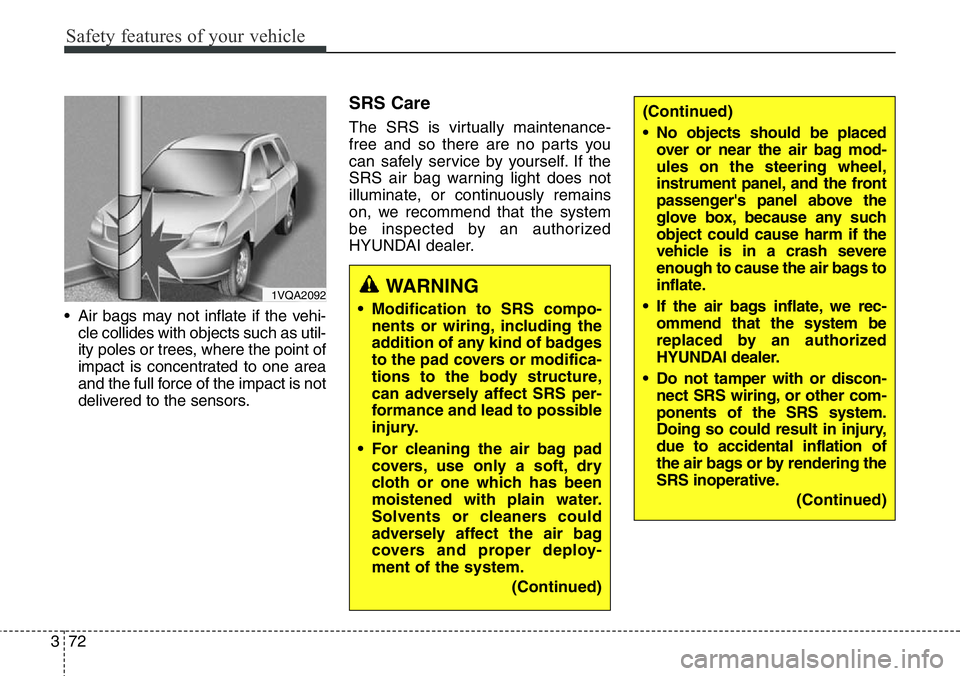
Safety features of your vehicle
72 3
• Air bags may not inflate if the vehi-
cle collides with objects such as util-
ity poles or trees, where the point of
impact is concentrated to one area
and the full force of the impact is not
delivered to the sensors.
SRS Care
The SRS is virtually maintenance-
free and so there are no parts you
can safely service by yourself. If the
SRS air bag warning light does not
illuminate, or continuously remains
on, we recommend that the system
be inspected by an authorized
HYUNDAI dealer.
1VQA2092WARNING
• Modification to SRS compo-
nents or wiring, including the
addition of any kind of badges
to the pad covers or modifica-
tions to the body structure,
can adversely affect SRS per-
formance and lead to possible
injury.
• For cleaning the air bag pad
covers, use only a soft, dry
cloth or one which has been
moistened with plain water.
Solvents or cleaners could
adversely affect the air bag
covers and proper deploy-
ment of the system.
(Continued)
(Continued)
• No objects should be placed
over or near the air bag mod-
ules on the steering wheel,
instrument panel, and the front
passenger's panel above the
glove box, because any such
object could cause harm if the
vehicle is in a crash severe
enough to cause the air bags to
inflate.
• If the air bags inflate, we rec-
ommend that the system be
replaced by an authorized
HYUNDAI dealer.
• Do not tamper with or discon-
nect SRS wiring, or other com-
ponents of the SRS system.
Doing so could result in injury,
due to accidental inflation of
the air bags or by rendering the
SRS inoperative.
(Continued)